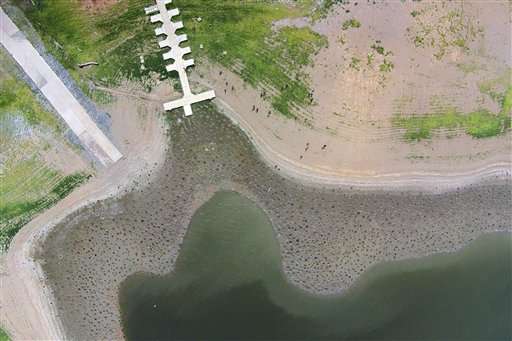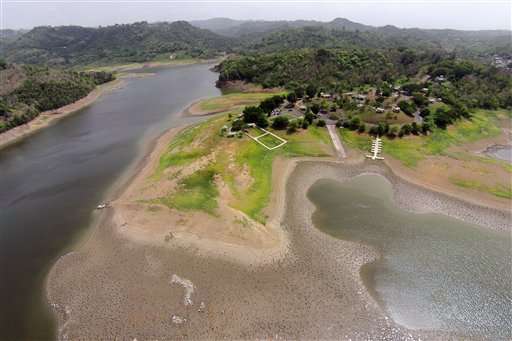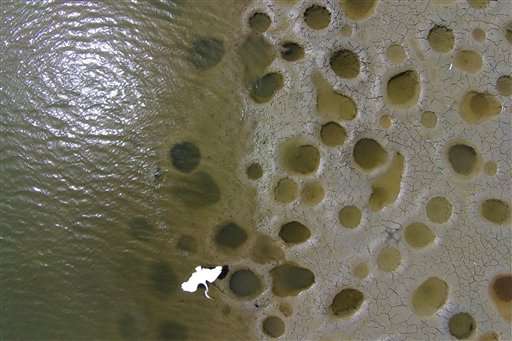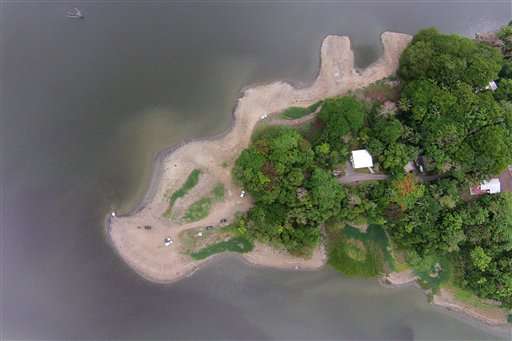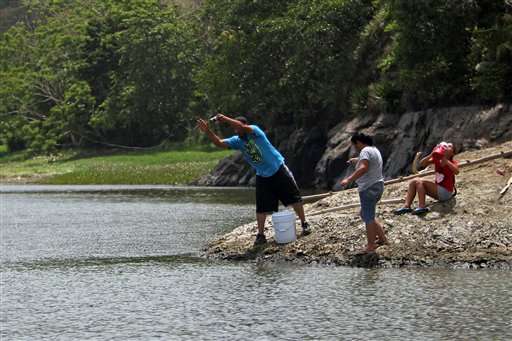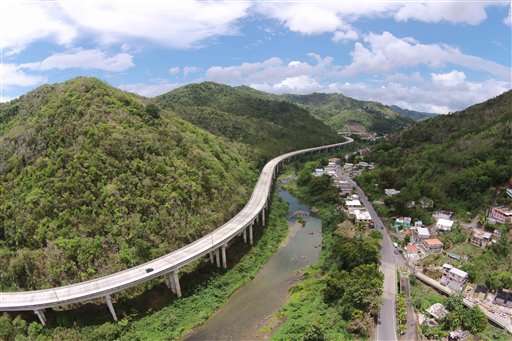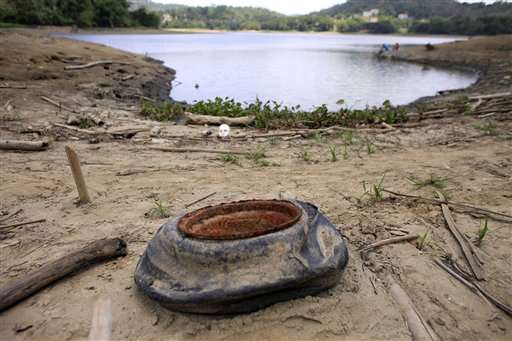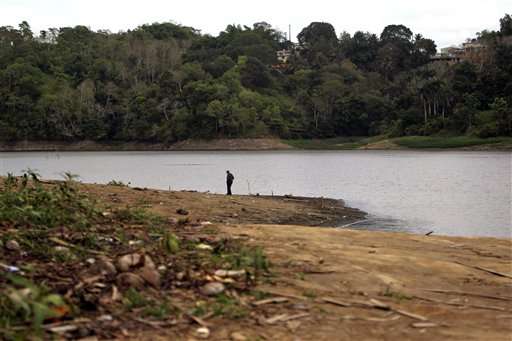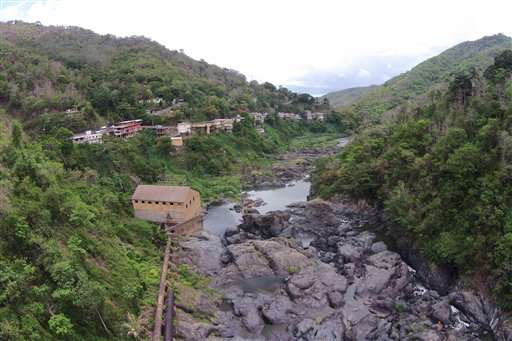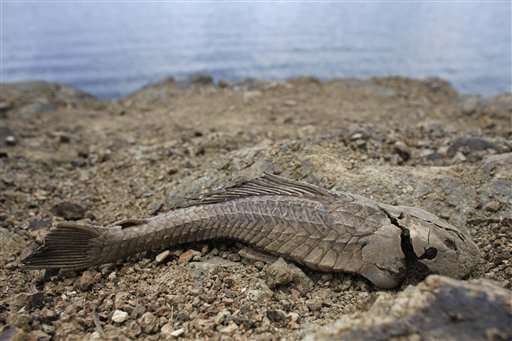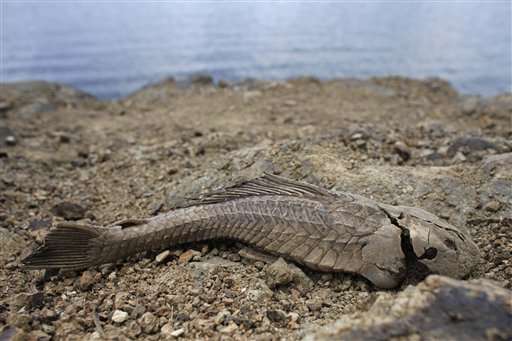This June 19, 2015 aerial photo shows a boat ramp and dock rising high above the waterline of La Plata reservoir in Toa Alta, Puerto Rico. Puerto Rico expanded water rationing across several municipalities as it continues to confront a drought of potentially historic proportions. More than 200,000 people are now facing regular water supply cutoffs as the government tries to mitigate the crisis. (AP Photo/Ricardo Arduengo)
The worst drought in five years is creeping across the Caribbean, prompting officials around the region to brace for a bone dry summer.
From Puerto Rico to Cuba to the eastern Caribbean island of St. Lucia, crops are withering, reservoirs are drying up and cattle are dying while forecasters worry that the situation could only grow worse in the coming months.
Thanks to El Nino, a warming of the tropical Pacific that affects global weather, and a quieter-than-normal hurricane season that began in June, forecasters expect a shorter wet season. That means less rain to help refill Puerto Rico's thirsty Carraizo and La Plata reservoirs as well as the La Plata river in the central island community of Naranjito. A tropical disturbance that hit the U.S. territory on Monday did not fill up those reservoirs as officials had anticipated.
Puerto Rico is among the Caribbean islands worst-hit by the water shortage, with more than 1.5 million people affected by the drought so far, according to the U.S. National Drought Mitigation Center.
Tens of thousands of people receive water only every third day under strict rationing recently imposed by the island government. Puerto Rico last week also activated National Guard troops to help distribute water and approved a resolution to impose fines on people and businesses for improper water use.
The Caribbean's last severe drought was in 2010. The current one could grow worse if the hurricane season ending in November produces scant rainfall and the region enters the dry season with parched reservoirs, said Cedric Van Meerbeeck, a climatologist with the Caribbean Institute for Meteorology and Hydrology.
"We might have serious water shortages ... for irrigation of crops, firefighting, domestic consumption or consumption by the hotel sector," he said.
This June 19, 2015 aerial photo shows the drought affected lakeshore of La Plata reservoir in Toa Alta, Puerto Rico. Puerto Rico expanded water rationing across several municipalities as it continues to confront a drought of potentially historic proportions. Thanks to El Nino, a warming of the tropical Pacific Ocean that affects global weather, and a quieter-than-normal hurricane season that began in June, forecasters expect a shorter wet season. (AP Photo/Ricardo Arduengo)
The Caribbean isn't the only area in the Western Hemisphere dealing with extreme water shortages. Brazil has been struggling with its own severe drought that has drained reservoirs serving the metropolis of Sao Paulo.
In the Caribbean, the farm sector has lost more than $1 million in crops as well as tens of thousands of dollars in livestock, said Norman Gibson, scientific officer at the Trinidad-based Caribbean Agricultural Research and Development Institute.
On St. Lucia, which has been especially hard hit, farmers say crops including coconuts, cashews and oranges are withering.
"The outlook is very, very bad," said Anthony Herman, who oversees a local farm cooperative. "The trees are dying, the plants are dying ... It's stripping the very life of rivers."
Officials in Cuba say 75 percent of the island is enduring a drought that has killed cattle and destroyed thousands of hectares (acres) of crops including plantains, citrus, rice and beans. Recent heavy rains in some areas have alleviated the problem some, but all 200 government-run reservoirs are far below capacity.
In the nearby Dominican Republic, water shortages have been reported in hundreds of communities, said Martin Melendez, a civil engineer and hydrology expert who has worked as a government consultant. "We were 30 days away from the entire water system collapsing," he said.
This June 19, 2015 aerial photo shows a white heron taking flight over revealed fish nests, normally inches below the waterline in La Plata reservoir in Toa Alta, Puerto Rico. Thanks to El Nino, a warming of the tropical Pacific Ocean that affects global weather, less rain fell to help refill Puerto Rico's La Plata reservoir, as well as La Plata river in the central island community of Naranjito. A tropical disturbance that hit the U.S. territory on Monday did not fill up those reservoirs as officials had anticipated. (AP Photo/Ricardo Arduengo)
The tourism sector has also been affected.
Most large hotels in Puerto Rico have big water tanks and some recycle wastewater to irrigate green areas, but many have curtailed water use, said Frank Comito, CEO of the Florida-based Caribbean Hotel & Tourism Association.
Other hotels have cut back on sprinkler time by up to 50 percent, said Carlos Martinez of Puerto Rico's Association of Hotels. "Everybody here is worried," he said. "They are selling water tanks like hot cakes ... and begging God for rain."
This June 15, 2015 aerial photo shows the drought affected lakeshore of the Carraizo reservoir in Trujillo Alto, Puerto Rico. Much of the Caribbean is experiencing the worst drought in years, threatening crops and forcing people to cut back on water consumption in Puerto Rico, Cuba, the Dominican Republic and elsewhere with no relief in sight. (AP Photo/Ricardo Arduengo)
Guests at Puerto Rico's El Canario by the Lagoon hotel get a note with their room keys asking them to keep their showers short amid the water shortage. "We need your cooperation to avoid waste," says the message distributed at the front desk of the hotel in the popular Condado district.
At the Casa del Vega guesthouse in St. Lucia, tourists sometimes find the water in their rooms turned off for the day, preventing them from taking a shower. "Even though we have a drought guests are not sympathetic to that," hotel manager Merlyn Compton said.
-
In this June 15, 2015 photo, a man casts fishing line from the banks of the unusually low Carraizo reservoir in Trujillo Alto, Puerto Rico. Puerto Rico is among the Caribbean islands worst-hit by the current water shortage, with more than 1.5 million people alone affected by the drought so far, according to the U.S. National Drought Mitigation Center. (AP Photo/Ricardo Arduengo)
-
This June 11, 2015 aerial photo shows the dry banks of La Plata River in Comerio, in central Puerto Rico. The Caribbean's last severe drought was in 2010. The current one could grow worse if the hurricane season ending in November produces scant rainfall and the region enters the dry season with parched reservoirs, said Cedric Van Meerbeeck, a climatologist with the Caribbean Institute for Meteorology and Hydrology. (AP Photo/Ricardo Arduengo)
-
In this June 15, 2015 photo, a discarded tire sits on the banks of the unusually low Carraizo reservoir in Trujillo Alto, Puerto Rico. In the midst of a drought, Puerto Rico activated National Guard troops to help distribute water and approved a resolution to impose fines on people and businesses for improper water use. (AP Photo/Ricardo Arduengo)
-
In this June 15, 2015 photo, a man stands on the banks of the unusually low Carraizo reservoir in Trujillo Alto, Puerto Rico. Tens of thousands of people receive water only every third day under strict rationing recently imposed by the island government. (AP Photo/Ricardo Arduengo)
-
This June 11, 2015 aerial photo shows the dry banks of La Plata River in Comerio, in central Puerto Rico. Puerto Rico is among the Caribbean islands worst-hit by the water shortage, with more than 1.5 million people alone affected by the drought so far, according to the U.S. National Drought Mitigation Center. (AP Photo/Ricardo Arduengo)
-
In this June 15, 2015 photo, a fish carcass litters the banks of the unusually low Carraizo reservoir in Trujillo Alto, Puerto Rico. From Puerto Rico to Cuba to the eastern Caribbean island of St. Lucia, crops are withering, reservoirs are drying up and cattle are dying while forecasters worry that the situation could only grow worse in the months to come. (AP Photo/Ricardo Arduengo)
-
In this June 15, 2015 photo, a fish carcass litters the banks of the unusually low Carraizo reservoir in Trujillo Alto, Puerto Rico. From Puerto Rico to Cuba to the eastern Caribbean island of St. Lucia, crops are withering, reservoirs are drying up and cattle are dying while forecasters worry that the situation could only grow worse in the months to come. (AP Photo/Ricardo Arduengo)
© 2015 The Associated Press. All rights reserved.
